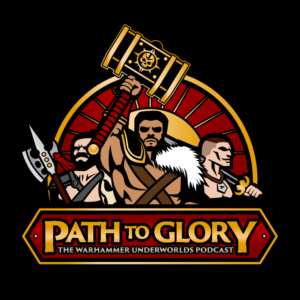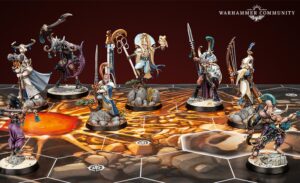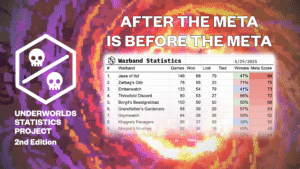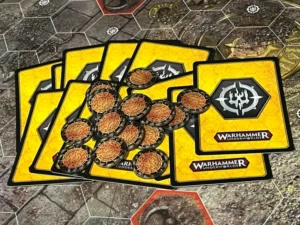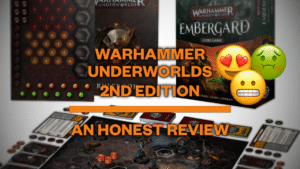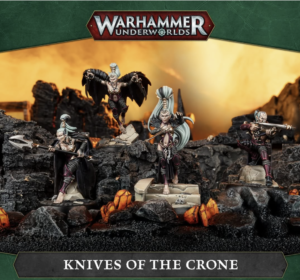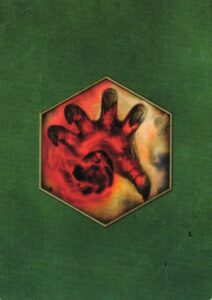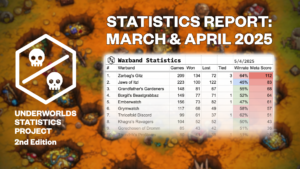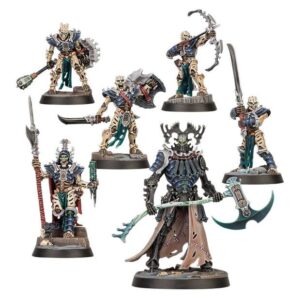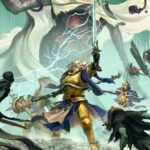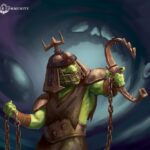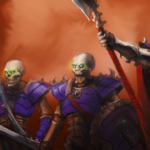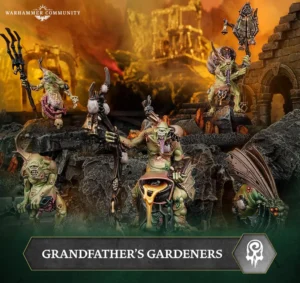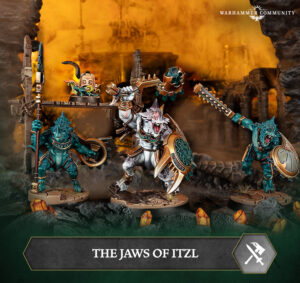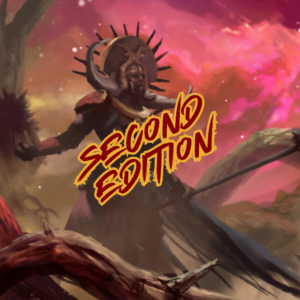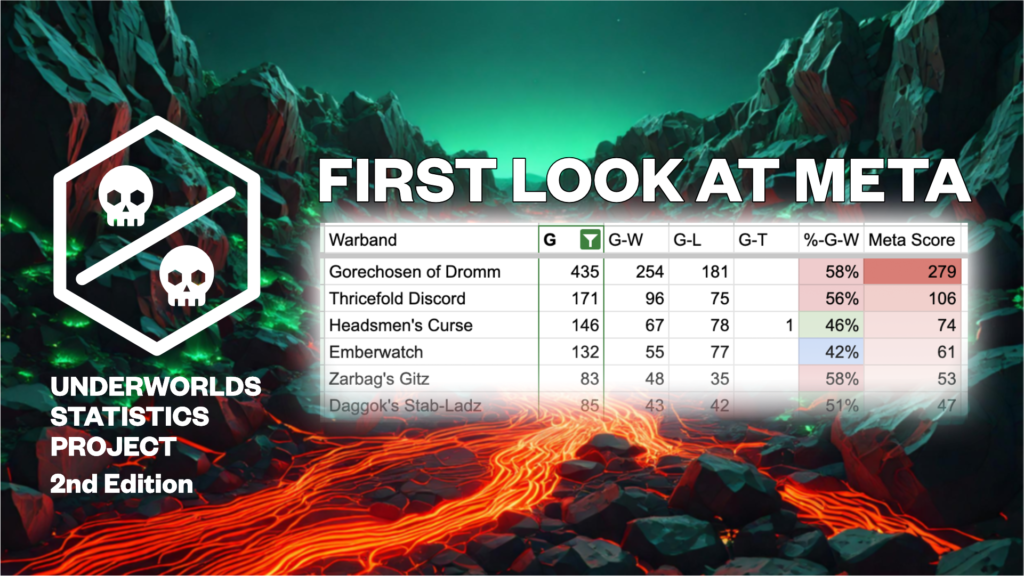
Hello everyone, Borni here, maintainer of the Underworlds Statistics Project. I’m excited to share the first report on the Warhammer Underworlds metagame for the second edition. This report covers games recorded up to December 27th, and provides a detailed look at both Warband and Deck performance. We’ve collected data from a total of 909 games, with 330 of those stemming from the World Championship of Warhammer. A big thank you to all the tournament organizers and volunteers who have submitted data from 6 tournaments. The spreadsheet containing the data can be viewed here.

This is also a call to action! To improve the accuracy and depth of our statistics, we need more organizers to step up and submit their results, or for people to volunteer to do so on their behalf. I hope this report will serve as a motivation for more people to get involved (see navigation menu for all relevant resources, including the submission form for individual games).
In general, most of the rankings are sorted not by winrate but by the so-called metascore. The metascore considers both the popularity and the success of a variable. To be precise, the metascore is the share of games won with a particular variable (e.g., a warband) among all games. It’s relative, with a maximum of 1000 points awarded among all values.
Caveats
It’s important to note that these statistics aren’t scientifically sound. The data is too heterogeneous, and the data collection process is too spotty. A much stricter and cohesive approach would be needed for adhering to scientific standards. Nevertheless, these statistics should provide a good indication of the international metagame.
Overall Conclusion
The statistics are heavily shaped by the World Championship, which introduces a skew in the data. The two elite warbands from the Chaos Grand Alliance, Gorechosen of Dromm and Thricefold Discord, are clearly dominating. Overall, elite warbands are favored in this new edition. The deck meta appears very aggro-focused and is defined by easy-to-score objectives. On a personal note, decks seem way more consistent than in the last edition. Besides these dominating factors, we are experiencing chaotic times, so the meta is still pretty unstable and the rankings could shift significantly in a short amount of time.
Warband Stats
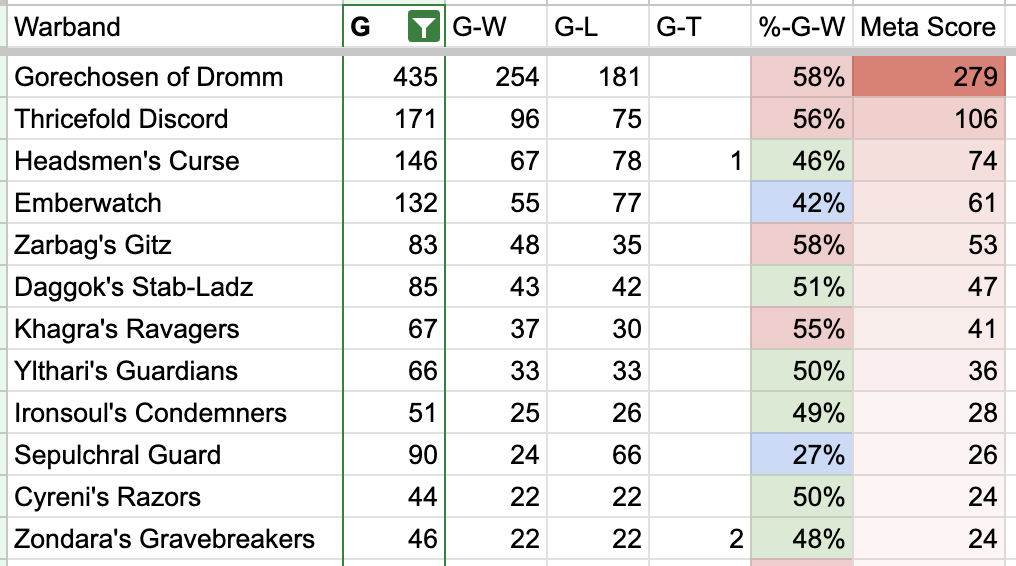
The top 4 warbands are all elite warbands. The only horde warbands in the top 12 are Zarbag’s Gitz, the badly performing Sepulchral Guard, and Zondara’s Gravebreakers in last place with a decent winrate. Gorechosen of Dromm and Thricefold Discord make up nearly 400 out of 1000 possible metascore points, underlying how dominant they really are. The success of Khagra’s Ravagers and Ylthari’s Guardians might be surprising, but they are decent choices. What you can also see is that there is an absence of new releases except Emberwatch. Grandfather’s Gardeners and Jaws of Itzl are probably too recent to appear in the ranking. On the other hand, Zikkit’s Tunnelpack have drastic design flaws, and people apparently aren’t willing to play them simply because they’re underpowered.
Deck Stats
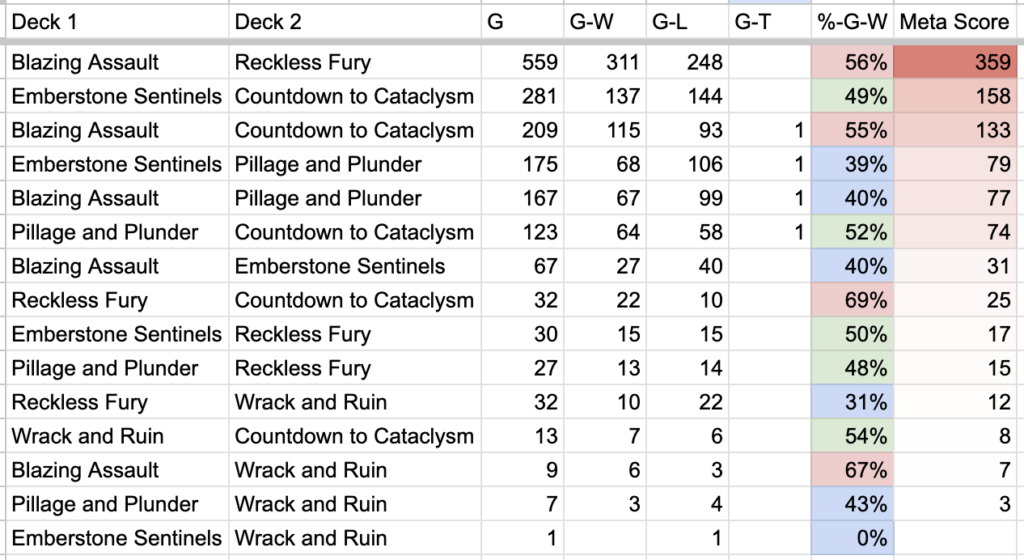
We can discern two groups of relevant deck combinations. In the first group, we have Blazing Assault combined with Reckless Fury, Emberstone Sentinels combined with Countdown to Cataclysm, and Blazing Assault combined with Countdown to Cataclysm. These are at the top, making up 650 of the 1000 potential metascore points. The second group consists of Emberstone Sentinels combined with Pillage and Plunder, Blazing Assault combined with Pillage and Plunder, and Pillage and Plunder combined with Countdown to Cataclysm. This second group is strongly defined by the flex deck Pillage and Plunder. These all have similar metascores, but this group is much less relevant than the first group.
Three combinations are especially noteworthy: Blazing Assault and Countdown to Cataclysm is very prominent, combining two decks with very easy-to-score glory. Blazing Assault and Reckless Fury is another prominent option, presenting a suppressive heavy aggro skew. Emberstone Sentinels and and Countdown to Cataclysm on the second place highlights that holding objectives is also pretty strong, at least if supported by the easy glory of the supplementary deck and ways of gaming Supremacy. The rest of the deck combinations are pretty irrelevant. What’s interesting to me is the status of Countdown to Cataclysm as a kind of kingmaker, as it pairs well with everything. On a personal note, I would say that this deck is plagued by design flaws because the Cataclysm mechanic provides no real tension during gameplay. It just scores glory pretty automatically without much room for counterplay, and the deck lacks internal synergy. Wrack and Ruin might be on its tail. It already shows good performance with both Reckless Fury and Blazing Assault, so this could become a very prominent supplementary deck.
Warband-Deck Stats
With World Championship Data
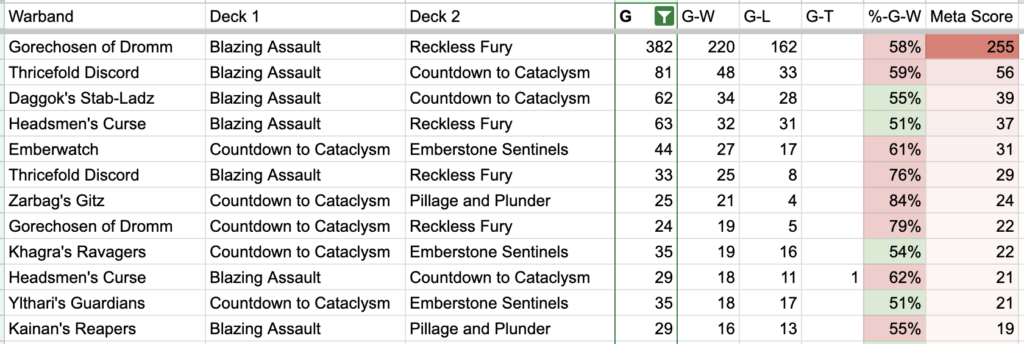
Regarding overall stats, in the top 12, Gorechosen of Dromm, Headsmen’s Curse, and Thricefold Discord all appear twice, underlining how dominant these elite warbands are. Daggok’s Stab-Ladz are in third place, so they appear quite prominent and have apparently benefited a lot from the new Warscroll and Fighter cards. They have multiple direct damage mechanics, which are pretty strong. Kainan’s Reapers and Zarbag’s Gitz are the only hordes in the top 12. There’s a low sample size for Zarbag’s Gitz with the particular deck combination of Countdown to Cataclysm and Pillage and Plunder, but it seems pretty overpowered. This is likely due to the high wound count of the warband, its decent damage output, and the fact that the Scurry mechanic in its current form can be easily abused, so the action economy is way too strong. Overall, the warband-deck combinations in the top 12 are overperforming across the board; 8 out of 12 entries on this list have a winrate above 55%, which is problematic.
Without World Championship Data
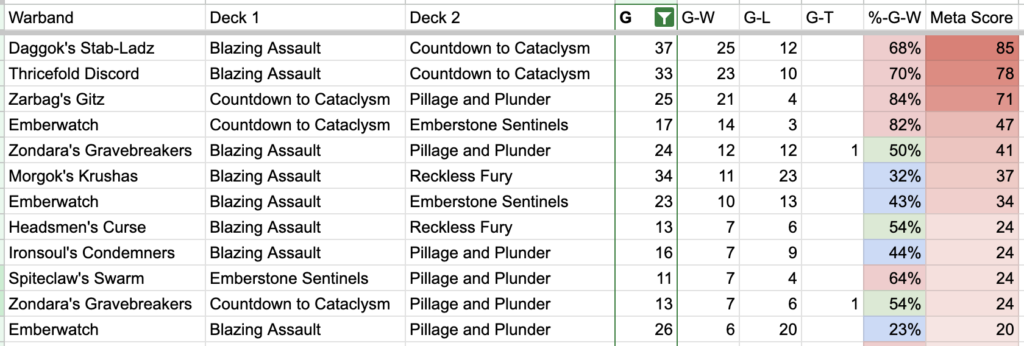
Here, the rankings shift significantly. Gorechosen of Dromm don’t appear in this ranking, which shows us that there is a soft ban among players regarding Gorechosen of Dromm. This warband simply isn’t played, most likely because people feel like they’re just too strong and don’t provide fair competition. But this isn’t the case for Thricefold Discord and Headsmen’s Curse; they still appear in the ranking. Emberwatch appear 3 times, making them the most dominant warband, however they only perform well with Countdown to Cataclysm and Emberstone Sentinels. Daggok’s Stab-Ladz and Zarbag’s Gitz appear very strong in this ranking, and there might be rising stars in the overall meta. Also, there are now 4 horde warbands in the ranking, so without the World Championship data, the situation of hordes seems improved.
Warband Podium Stats
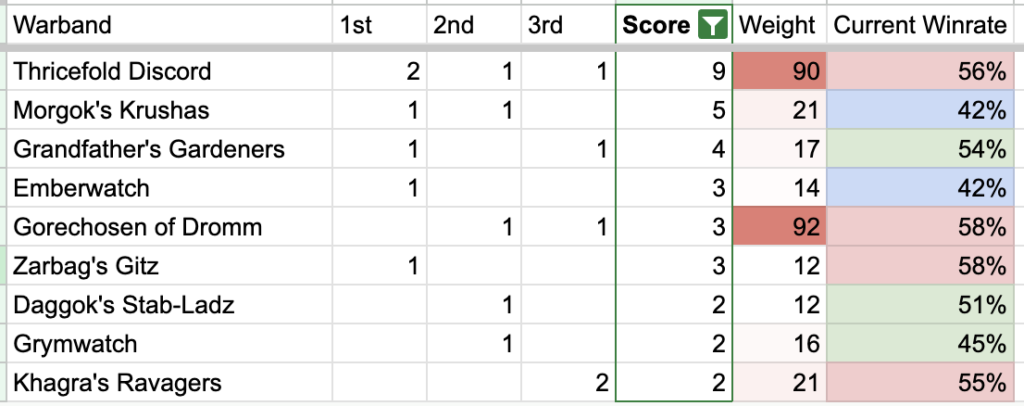
These are sorted according to a score system: 3 points for first place, 2 for second, and 1 for third. The weight is the sum of the player counts of the tournaments the warband podiumed in. This gives another perspective on how relevant a placing of a warband really is, because it’s way harder to win a 16-player tournament than a 6-player one. Looking at this ranking, we see that 4 out of 6 top-performing warbands are elites. Grandfather’s Gardeners are probably rising stars and will become more dominant in the next weeks and months. Here, it also becomes apparent that Gorechosen of Dromm were soft-banned after the World Championship, while Thricefold Discord wasn’t. So Thricefold Discord was still played and won at tournaments after the World Championship, while the performance of Gorechosen of Dromm is limited to this particular event. But of course, they didn’t get worse; they probably just weren’t played that much or at all. Daggok’s Stab-Ladz perform very well, so it seems likely that they will accumulate more placements in the future. Morgok’s Krushas place well in tournaments but aren’t that dominant in the overall statistics yet, and this could also change in the future.
Deck Podium Stats

Here, we see that Aggro and Flex are the most dominant choices, and we also see that Wrack and Ruin already shows good performance. It isn’t being played much yet, but it will likely become more popular as a kind of supplementary deck similar to Countdown to Cataclysm. You combine it with something else, and then it becomes very strong.
Conclusion
Overall, I would say that surprisingly little has changed regarding the metagame if you compare it to the last edition. The Elite Aggro Meta is back in full swing. Hordes are overall still underperforming, whereas exceptions prove a rule. The key for horde warbands lies in mechanics that provide abusable action efficiency or a countermeasure to glory bleed, as seen with Grandfather’s Gardeners. Similar to the last edition, a ping meta might be on the rise, and there are already several data points for this hypothesis.
The current state of the game shows significant room for improvement, which is both a blessing and a curse. The very strong pairings of decks and warbands became apparent very fast, especially at the World Championship of Warhammer before the game could even be played by all players. This shows that Underworlds needs to be tightly balanced, as players can more or less freely combine multiple strong mechanics and abuse them for maximum efficiency. We already know what can be abused, and therefore it would be possible to change these factors to tone them down.
On a personal note, the deck balance isn’t to my liking. The game has shifted strongly in the direction of objectives that are basically automatically scored. Also, there are a lot of accuracy and damage buffs combined with strong defensive upgrades. These factors will inevitably push already strong elite fighters over the edge. This is likely reinforced by the ability to reuse already spent glory for new upgrades, allowing for a strong snowball effect where you can easily stack multiple strong upgrades onto the next fighter.
I hope you have enjoyed these statistics. I’m looking forward to your comments on Discord or social media. I will get back to you with another report on the statistics once we get more games and tournaments recorded, and hopefully also after the first real balance patch, which, as the data shows, is quite necessary. You can find all resources of the project via the navigation menu.
